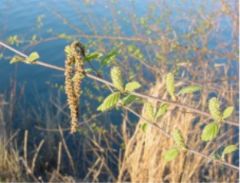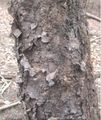Water Birch: Difference between revisions
No edit summary |
No edit summary |
||
| (2 intermediate revisions by the same user not shown) | |||
| Line 1: | Line 1: | ||
{{SPlantbox | {{SPlantbox | ||
|common_name=Water Birch | |familia=Betulaceae | ||
|genus=Betula | |||
|species=nigra | |||
|taxo_author=L. | |||
|common_name=Water Birch, River Birch | |||
|habit=tree | |||
|habit_ref=Complete Landscaping - ISBN 9780376009272 | |||
|Min ht box=40 | |||
|Min ht metric=ft | |||
|Max ht box=80 | |||
|Max ht metric=ft | |||
|height_ref=Complete Landscaping - ISBN 9780376009272 | |||
|lifespan=perennial | |||
|life_ref=Complete Landscaping - ISBN 9780376009272 | |||
|exposure=sun | |||
|sun_ref=Complete Landscaping - ISBN 9780376009272 | |||
|water=wet, moist | |||
|water_ref=Complete Landscaping - ISBN 9780376009272 | |||
|features=deciduous, fall color | |||
|Temp Metric=°F | |Temp Metric=°F | ||
| | |min_zone=3 | ||
|image= | |usda_ref=Complete Landscaping - ISBN 9780376009272 | ||
|max_zone=9.5 | |||
|image=Birch blossom.jpg | |||
|image_width=240 | |image_width=240 | ||
|image_caption=River birch with male [[catkin]]s | |||
}} | }} | ||
'''Water Birch''', '''Red Birch''' or, '''River Birch''' (''Betula nigra'') is a common small [[birch]] native in [[flood plain]]s or [[swamp]]s in the [[Eastern United States|eastern]] [[United States]] from [[New Hampshire]] west to southern [[Minnesota]], and south to northern [[Florida]] and east [[Texas]]. | |||
It is a small [[deciduous]] [[tree]] growing to about 25 m tall at most. The [[bark]] is very variable, usually dark gray-brown to pinkish-brown and thickly scaly, but in some individuals, smooth and creamy pinkish-white, exfoliating in curly papery sheets. The [[leaf|leaves]] are alternate, ovate, 5-12 cm long and 4-9 cm broad, with a serrated margin. The [[flower]]s are wind-pollinated [[catkin]]s 3-6 cm long, the male catkins pendulous, the female catkins erect. The [[fruit]] is unusual among birches in maturing in late spring; it is composed of numerous tiny winged seeds packed between the catkin bracts. | |||
{{Inc| | {{Inc| | ||
Betula nigra, Linn. (B. rubra. Michx.). Red or River Birch. Tree 50-90 ft.: bark reddish brown, or silvery gray on younger branches, separating into numerous thin, papery flakes: branchlets pubescent: petioles scarcely ½in. long: Lvs. rhombic-ovate, acute, doubly serrate, pubescent when young, at length only on the veins beneath, pale or glaucescent beneath, 2-3½ in. long: cones 1-1 ⅔ in. long, cylindrical, ripening in May or June; scales pubes cent, with erect, linear-oblong, nearly equal lobes. From Mass, south to Fla. and west to Kan. and Minn | Betula nigra, Linn. (B. rubra. Michx.). Red or River Birch. Tree 50-90 ft.: bark reddish brown, or silvery gray on younger branches, separating into numerous thin, papery flakes: branchlets pubescent: petioles scarcely ½in. long: Lvs. rhombic-ovate, acute, doubly serrate, pubescent when young, at length only on the veins beneath, pale or glaucescent beneath, 2-3½ in. long: cones 1-1 ⅔ in. long, cylindrical, ripening in May or June; scales pubes cent, with erect, linear-oblong, nearly equal lobes. From Mass, south to Fla. and west to Kan. and Minn.— A moisture-loving, graceful tree, with slender, very numerous branches, and remarkable for its torn and ragged bark. | ||
}} | }} | ||
==Cultivation== | |||
While its native habitat is wet ground, it will grow on higher land, and its [[bark]] is quite distinctive, making it a favored ornamental tree for [[landscape architecture|landscape use]]. A number of [[cultivar]]s with much whiter bark than the normal wild type have been selected for garden planting, including 'Heritage' and 'Dura Heat'; these are notable as the only white-barked birches resistant to the [[bronze birch borer]] ''Agrilus anxius'' in warm areas of the southeastern United States of America. | |||
===Propagation=== | |||
===Pests and diseases=== | |||
==Varieties== | |||
==Gallery== | |||
= | <gallery perrow=5> | ||
Image:Riverbirch 8003.jpg|''Betula nigra'' Trunk, showing the bark pattern typical of most wild trees | |||
Image:Betula nigra Heritage.jpg|The cultivar 'Heritage', selected for its white bark, here in fall leaf colors | |||
Image:Upload.png| photo 1 | |||
Image:Upload.png| photo 2 | |||
Image:Upload.png| photo 3 | |||
</gallery> | |||
[[ | ==References== | ||
<references/> | |||
*[[Standard Cyclopedia of Horticulture]], by L. H. Bailey, MacMillan Co., 1963 | |||
<!--- xxxxx *Flora: The Gardener's Bible, by Sean Hogan. Global Book Publishing, 2003. ISBN 0881925381 --> | |||
<!--- xxxxx *American Horticultural Society: A-Z Encyclopedia of Garden Plants, by Christopher Brickell, Judith D. Zuk. 1996. ISBN 0789419432 --> | |||
<!--- xxxxx *Sunset National Garden Book. Sunset Books, Inc., 1997. ISBN 0376038608 --> | |||
==External links== | ==External links== | ||
* | *{{wplink}} | ||
{{ | {{stub}} | ||
__NOTOC__ | |||
Latest revision as of 20:33, 7 May 2011
| Betula nigra subsp. var. | Water Birch, River Birch | |||||||||||||||||||||||||||||||||||||||||||||||||||||||
|---|---|---|---|---|---|---|---|---|---|---|---|---|---|---|---|---|---|---|---|---|---|---|---|---|---|---|---|---|---|---|---|---|---|---|---|---|---|---|---|---|---|---|---|---|---|---|---|---|---|---|---|---|---|---|---|---|

|
|
| ||||||||||||||||||||||||||||||||||||||||||||||||||||||
| ||||||||||||||||||||||||||||||||||||||||||||||||||||||||
Water Birch, Red Birch or, River Birch (Betula nigra) is a common small birch native in flood plains or swamps in the eastern United States from New Hampshire west to southern Minnesota, and south to northern Florida and east Texas.
It is a small deciduous tree growing to about 25 m tall at most. The bark is very variable, usually dark gray-brown to pinkish-brown and thickly scaly, but in some individuals, smooth and creamy pinkish-white, exfoliating in curly papery sheets. The leaves are alternate, ovate, 5-12 cm long and 4-9 cm broad, with a serrated margin. The flowers are wind-pollinated catkins 3-6 cm long, the male catkins pendulous, the female catkins erect. The fruit is unusual among birches in maturing in late spring; it is composed of numerous tiny winged seeds packed between the catkin bracts.
| Standard Cyclopedia of Horticulture |
|---|
|
Betula nigra, Linn. (B. rubra. Michx.). Red or River Birch. Tree 50-90 ft.: bark reddish brown, or silvery gray on younger branches, separating into numerous thin, papery flakes: branchlets pubescent: petioles scarcely ½in. long: Lvs. rhombic-ovate, acute, doubly serrate, pubescent when young, at length only on the veins beneath, pale or glaucescent beneath, 2-3½ in. long: cones 1-1 ⅔ in. long, cylindrical, ripening in May or June; scales pubes cent, with erect, linear-oblong, nearly equal lobes. From Mass, south to Fla. and west to Kan. and Minn.— A moisture-loving, graceful tree, with slender, very numerous branches, and remarkable for its torn and ragged bark.
|
Cultivation
While its native habitat is wet ground, it will grow on higher land, and its bark is quite distinctive, making it a favored ornamental tree for landscape use. A number of cultivars with much whiter bark than the normal wild type have been selected for garden planting, including 'Heritage' and 'Dura Heat'; these are notable as the only white-barked birches resistant to the bronze birch borer Agrilus anxius in warm areas of the southeastern United States of America.
Propagation
Pests and diseases
Varieties
Gallery
-
Betula nigra Trunk, showing the bark pattern typical of most wild trees
-
The cultivar 'Heritage', selected for its white bark, here in fall leaf colors
-
photo 1
-
photo 2
-
photo 3
References
- Standard Cyclopedia of Horticulture, by L. H. Bailey, MacMillan Co., 1963
External links
- w:Water Birch. Some of the material on this page may be from Wikipedia, under the Creative Commons license.
- Water Birch QR Code (Size 50, 100, 200, 500)


